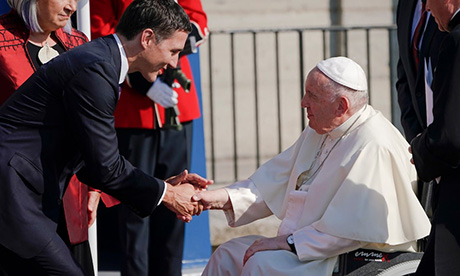Last month, Pope Francis came to Canada and expressed regret for the Roman Catholic Church’s part in running notoriously abusive residential schools for Indigenous children, which operated between 1880 and 1996.
“I humbly beg forgiveness for the evil committed by so many Christians against the Indigenous peoples,” the pope said. Canada’s own government has previously expressed its regret.
Francis was in Canada to apologize, not to preach — which may be why he said relatively little about that country’s legalization of euthanasia in 2016.
Rebranded as “medical assistance in dying,” or MAID, the formerly taboo practice is now hailed in Canada as both humane medical care and essential to patient autonomy. It enjoys strong support in opinion polls and the full backing of Prime Minister Justin Trudeau’s federal government.
Still, Francis’s church is doctrinally opposed to euthanasia, and he has personally condemned it, so the pope did allude, in one of his public addresses, to “patients who, in place of affection, are administered death.”
He could, and should, have said more. Even before Francis’s visit, there was evidence euthanasia has problems.
Between 2016 and 2021, Canadian medical personnel administered lethal doses to more than 31,000 people who were usually — but not always — terminally ill.
Since 2019, Canadian law has said that “intolerable” suffering due to “incurable” illness, which could include various chronic disabling conditions, may be sufficient to qualify for a lethal injection.
These permissive standards may be resulting in avoidable death or distress for vulnerable people, and disability rights advocates are expressing concern, as Maria Cheng of the Associated Press reported Aug. 11.
She told the story of 61-year-old Alan Nichols, who requested — and received — euthanasia less than a month after entering a British Columbia hospital in June 2019, suffering from suicidal thoughts, dehydration and malnutrition.
The decision was apparently based on a medical history that included serious but typically non-life-threatening conditions such as depression and hearing loss.
His grief-stricken family has sought explanations as to how doctors could have found their loved one competent to “choose” death much less needful of it.
“Somebody needs to take responsibility so that it never happens to another family,” Trish Nichols, Alan’s sister-in-law, told Cheng.
The family’s inquiries to provincial and federal authorities have so far produced only officials’ insistence that Alan met the criteria for physician-assisted death.
Cheng described the case of a man with amyotrophic lateral sclerosis, also known as ALS or Lou Gehrig’s disease, who felt driven to seek euthanasia because British Columbia officials would not provide him adequate support to live at home.
In a case separately reported by Canadian media this year, a 31-year-old Toronto woman with a disability sought and received approval for euthanasia after what she said was a futile search for safe housing — only to decide to continue living after private parties helped her find an appropriate dwelling.
While the details of these and other instances are difficult for outsiders to parse, and while it is true, as Canadian officials told Cheng, that 65 percent of euthanasia procedures have been performed on cancer patients, the issue’s very murkiness and subjectivity is a warning sign.
In this context, any mistake could be irreversible.
Cheng reports that, as compared with the other six countries where euthanasia is legal, Canada’s margin for error may be wider.
Canadian patients are not required to exhaust all treatment options before seeking MAID. Canada allows nurse practitioners as well as doctors to end patients’ lives.
Another warning sign: Last year, a top United Nations disability rights official wrote to Trudeau advising him that legalizing euthanasia for the non-terminally ill creates an implied negative judgment on “the value or quality of life of persons with disabilities.” Continue reading
